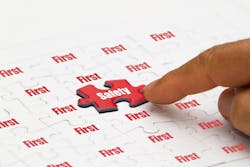This eighth and final part of Annex Q is titled, “Work Place Culture”. The word “culture” has been overused and misused in the business literature so much that it has taken on a trivial dimension. But in the electrical safety world, its meaning is anything but trivial. In this context, the workplace culture consists of the prevailing attitudes and core beliefs of the group. When a workplace has a positive safety culture, people tend to think safety first and the peer pressure to enforce that is pervasive. This culture doesn't just happen. It must be nurtured from top to bottom and from bottom to top.
“Workers, supervisors, and managers must all work together to implement strong human performance practices” [Q.8.1].
Workers take personal responsibility for their actions. They strive to improve themselves, the task at hand, and the work environment [Q.8.2]. The Annex lists five general practices that workers should consistently demonstrate. One of those is “Anticipation of error-likely situations and conditions” [Q.8.2(2)].
Supervisors and managers have several responsibilities in regard to the safety culture. Firstly, they must lead by example. In fact, Q.8.3, which discusses their responsibilities, begins with the words “Through their actions.” One of the jobs of any supervisor or manager is to identify and address problems that workers face; you can think of this as “running interference” or “optimizing the system.” Annex Q incorporates this concept in one of the five general practices it says supervisors and managers should demonstrate:
“Seek out and eliminate broader company weaknesses that may create opportunity for error” [Q.8.3(3)].
The organization itself has responsibilities. A key one is to recognize that people make mistakes. Annex Q lists five responsibilities the organization should demonstrate. One of those is “Promote open communication” [Q.8.4(1)]. This concept is often tossed around carelessly, so much talk but not actually implemented. When a worker can go to his or her supervisor and communicate openly, “I made a mistake,” then the supervisor can address that mistake. But if the worker conceals the mistake out of fear of reprisal for saying anything, guess what happens? Similarly, a worker should be able to openly communicate to his or her supervisor, “I think you made a mistake. Can we talk about it?”
About the Author

Mark Lamendola
Mark is an expert in maintenance management, having racked up an impressive track record during his time working in the field. He also has extensive knowledge of, and practical expertise with, the National Electrical Code (NEC). Through his consulting business, he provides articles and training materials on electrical topics, specializing in making difficult subjects easy to understand and focusing on the practical aspects of electrical work.
Prior to starting his own business, Mark served as the Technical Editor on EC&M for six years, worked three years in nuclear maintenance, six years as a contract project engineer/project manager, three years as a systems engineer, and three years in plant maintenance management.
Mark earned an AAS degree from Rock Valley College, a BSEET from Columbia Pacific University, and an MBA from Lake Erie College. He’s also completed several related certifications over the years and even was formerly licensed as a Master Electrician. He is a Senior Member of the IEEE and past Chairman of the Kansas City Chapters of both the IEEE and the IEEE Computer Society. Mark also served as the program director for, a board member of, and webmaster of, the Midwest Chapter of the 7x24 Exchange. He has also held memberships with the following organizations: NETA, NFPA, International Association of Webmasters, and Institute of Certified Professional Managers.
